Background
Parliamentary elections for the lower house of the Parliament of South Australia were held in South Australia in 1977. There was no election for Legislative Council; and as of 2020, this is the most recent South Australian election which has not been for both houses.
The Labor Party led by Don Dunstan, which had won the previous three elections in 1970, 1973 and 1975, defeated the Liberal Party of Australia opposition led by David Tonkin. It was the first time that a Labor government in South Australia had been re-elected for a fourth term, and would be the first nine-year-incumbent Labor government. This would be Dunstan's last election before resigning due to ill health in 1979.
This was the first election after the end of Playmander seat weighting where one vote one value was introduced. At the previous election some metropolitan seats still saw more than three times the number of voters than in some rural seats, despite most of the Playmander being abolished nearly a decade ago. The redistribution was the reason Dunstan called an early election. [1]
The Australian Democrats ran for the first time under a joint New LM-Australian Democrats ticket, winning an average 12.3 percent of the primary vote in the 12 electorates they contested, with former LCL MP Robin Millhouse retaining his seat of Mitcham, which he would hold until 1982.
This page is based on this
Wikipedia article Text is available under the
CC BY-SA 4.0 license; additional terms may apply.
Images, videos and audio are available under their respective licenses.

